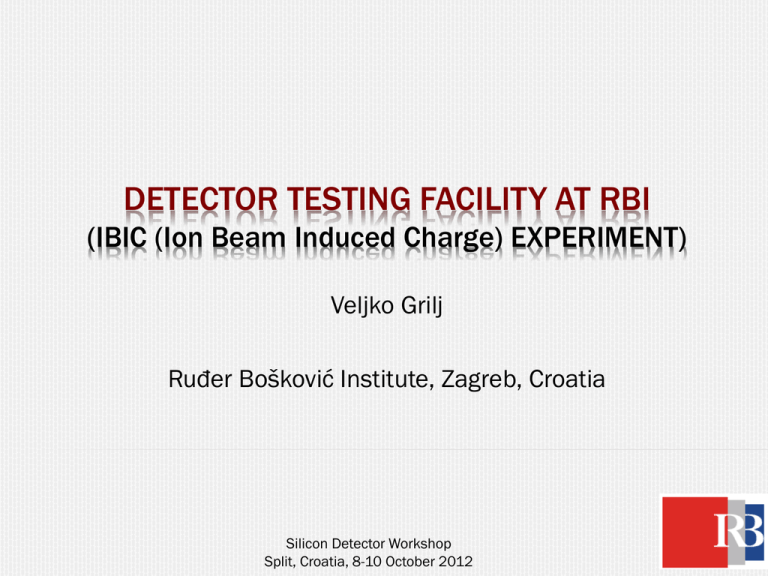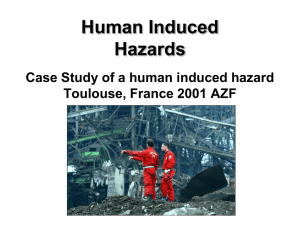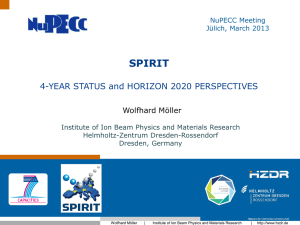Detector testing facility ay RBI
advertisement

DETECTOR TESTING FACILITY AT RBI (IBIC (Ion Beam Induced Charge) EXPERIMENT) Veljko Grilj Ruđer Bošković Institute, Zagreb, Croatia Silicon Detector Workshop Split, Croatia, 8-10 October 2012 1. ACCELERATORS 1.0 MV HVE Tandetron accelerator 6.0 MV EN Tandem Van de Graaff accelerator PIXE/RBS 1 2 In-air PIXE Dual-beam irradiation IAEA beam line TOF ERDA Det. test. Ion microprobe IBIC PIXE crystal spectrometer Nuclear reactions 1.1. New detector testing beam line 1. Beam deflector and/or scanner 2. Pre-chamber with beam degrader/diffuser 3. Final chamber with beam in air capability 1.2. Nuclear microprobe ION POSITION - focusing and scanning q u a d ru p o le d o u b le t fo c u s in g le n s s a m p le p ro to n beam o b je c t s lits IONS Y - p, , Li, C, O,.. X scan g e n e ra to r Y 16 O 12 C IB IC s ig n a l 7 X Li a lp h a s IB IC - c h a rg e c o lle c tio n e ffic ie n c y RANGE ION RATE - 2 to 200 m - currents 0 - 106 p/s im a g e s p ro to n s 1.3. Available ion beams 127I 100000 Number of charge pairs (ion*nm) -1 10000 1000 C Si 12C He Accel. voltages 0.1 to 6.0 MV Negative Ion sources: - Duoplasmatron - RF He - Sputtering Cu I 100 10 28Si protons 1 0,1 0,01 Eions = 1 MeV/amu MIPs proton 1E-3 1E-4 1E-5 1E-6 500 Depth (nm) 1000 Silicon I 127 Si 28 C 12 He 4 H1 Range(µm) E=1 MeV 0.37 1.13 1.6 3.5 16.3 4.8 9.5 69.7 709 Range (µm) 3.7 E=10 MeV 2. ION BEAM INDUCED CHARGE - theory Principles of radiation detection techniques Vout Q Deposited energy Free charge genetration and transport V Ouput signal Vout Vout = F (deposited energy, free carrier transport) Nuclear spectroscopy Well known 2. ION BEAM INDUCED CHARGE - theory Principles of IBIC Vout Q Deposited energy Free charge genetration and transport V Ouput signal Vout Vout = F (deposited energy, free carrier transport) Well known Material characterization 2. ION BEAM INDUCED CHARGE - theory Principles of IBIC b) Creation of e-h pairs a) Energy deposition by ions + + + - + - + + + - - 800 E n e rg y lo ss (ke V / m ) + - 700 2 M e V -p a rticle s 600 500 400 300 2 M e V p ro to n s 200 100 0 0 5 10 15 20 25 D e p th ( m ) Bethe formula: dE dx 4 e z 4 m0v 2 2 2 2 2m0v 2 v v NZ ln ln 1 2 2 I c c N e/h E dep eh MeV eV 10 6 2. ION BEAM INDUCED CHARGE - theory Principles of IBIC c) Free charge carrier transport → charge induced at electodes year 1964 E ( r ( t )) Gunn’s theorem: ii q v Vi Vout T=0 V j const . 1 .0 Q 0 .8 Q 0 .6 0 .4 0 .2 0 .0 d V 0 .0 7 5 I 0 .0 5 0 v I( t ) q 0 .0 2 5 v d 0 .0 0 0 -2 0 2 4 6 8 T im e 10 12 14 2. ION BEAM INDUCED CHARGE - theory Principles of IBIC c) Free charge carrier transport → charge induced at electodes E ( r ( t )) Gunn’s theorem: ii q v Vi Vout T=1 V j const . 1 .0 Q 0 .8 Q 0 .6 0 .4 0 .2 0 .0 d 0 .0 7 5 0 .0 5 0 I V I( t ) q 0 .0 2 5 v d 0 .0 0 0 -2 0 2 4 6 8 T im e 10 12 14 2. ION BEAM INDUCED CHARGE - theory Principles of IBIC c) Free charge carrier transport → charge induced at electodes E ( r ( t )) Gunn’s theorem: ii q v Vi Vout T=2 V j const . 1 .0 Q 0 .8 Q 0 .6 0 .4 0 .2 0 .0 d 0 .0 7 5 0 .0 5 0 I V I( t ) q 0 .0 2 5 v d 0 .0 0 0 -2 0 2 4 6 8 T im e 10 12 14 2. ION BEAM INDUCED CHARGE - theory Principles of IBIC c) Free charge carrier transport → charge induced at electodes E ( r ( t )) Gunn’s theorem: ii q v Vi Vout T=3 V j const . 1 .0 Q 0 .8 Q 0 .6 0 .4 0 .2 0 .0 d 0 .0 7 5 0 .0 5 0 I V I( t ) q 0 .0 2 5 v d 0 .0 0 0 -2 0 2 4 6 8 T im e 10 12 14 2. ION BEAM INDUCED CHARGE - theory Principles of IBIC c) Free charge carrier transport → charge induced at electodes E ( r ( t )) Gunn’s theorem: ii q v Vi Vout T=4 V j const . 1 .0 Q 0 .8 Q 0 .6 0 .4 0 .2 0 .0 d 0 .0 7 5 0 .0 5 0 I V I( t ) q 0 .0 2 5 v d 0 .0 0 0 -2 0 2 4 6 8 T im e 10 12 14 2. ION BEAM INDUCED CHARGE - theory Principles of IBIC c) Free charge carrier transport → charge induced at electodes E ( r ( t )) Gunn’s theorem: ii q v Vi Vout T=5 V j const . 1 .0 Q 0 .8 Q 0 .6 0 .4 0 .2 0 .0 d 0 .0 7 5 0 .0 5 0 I V I( t ) q 0 .0 2 5 v d 0 .0 0 0 -2 0 2 4 6 8 T im e 10 12 14 2. ION BEAM INDUCED CHARGE - theory Principles of IBIC c) Free charge carrier transport → charge induced at electodes E ( r ( t )) Gunn’s theorem: ii q v Vi Vout T=6 V j const . 1 .0 Q 0 .8 Q 0 .6 0 .4 0 .2 0 .0 d 0 .0 7 5 0 .0 5 0 I V I( t ) q 0 .0 2 5 v d 0 .0 0 0 -2 0 2 4 6 8 T im e 10 12 14 2. ION BEAM INDUCED CHARGE - theory Principles of IBIC c) Free charge carrier transport → charge induced at electodes E ( r ( t )) Gunn’s theorem: ii q v Vi Vout T=7 V j const . 1 .0 Q 0 .8 Q 0 .6 0 .4 0 .2 0 .0 d 0 .0 7 5 0 .0 5 0 I V I( t ) q 0 .0 2 5 v d 0 .0 0 0 -2 0 2 4 6 8 T im e 10 12 14 2. ION BEAM INDUCED CHARGE - theory Principles of IBIC c) Free charge carrier transport → charge induced at electodes E ( r ( t )) Gunn’s theorem: ii q v Vi Vout T=8 V j const . 1 .0 Q 0 .8 Q 0 .6 0 .4 0 .2 0 .0 d 0 .0 7 5 0 .0 5 0 I V I( t ) q 0 .0 2 5 v d 0 .0 0 0 -2 0 2 4 6 8 T im e 10 12 14 2. ION BEAM INDUCED CHARGE - theory Principles of IBIC c) Free charge carrier transport → charge induced at electodes E ( r ( t )) Gunn’s theorem: ii q v Vi Vout T=9 V j const . 1 .0 Q 0 .8 Q 0 .6 0 .4 0 .2 0 .0 d 0 .0 7 5 0 .0 5 0 I V I( t ) q 0 .0 2 5 v d 0 .0 0 0 -2 0 2 4 6 8 T im e 10 12 14 2. ION BEAM INDUCED CHARGE - theory Principles of IBIC c) Free charge carrier transport → charge induced at electodes E ( r ( t )) Gunn’s theorem: ii q v Vi Vout T=10 V j const . 1 .0 Q 0 .8 Q 0 .6 0 .4 0 .2 0 .0 d 0 .0 7 5 0 .0 5 0 I V I( t ) q 0 .0 2 5 v d 0 .0 0 0 -2 0 2 4 6 8 T im e 10 12 14 2. ION BEAM INDUCED CHARGE - theory Principles of IBIC c) Free charge carrier transport → charge induced at electodes E ( r ( t )) Gunn’s theorem: ii q v Vi Vout T=11 V j const . 1 .0 Q 0 .8 Q 0 .6 0 .4 0 .2 0 .0 d 0 .0 7 5 0 .0 5 0 I V 0 .0 2 5 0 .0 0 0 -2 0 2 4 6 8 T im e 10 12 14 2. ION BEAM INDUCED CHARGE - theory Principles of IBIC Impact of defects on charge carriers mobility: 1 .0 1 .0 0 .8 0 .8 0 .6 0 .6 Q tot q 0 .4 Q Q 0 .4 0 .2 0 .2 0 .0 0 .0 0 .0 7 5 I q 0 .0 7 5 d 0 .0 5 0 I v I 0 .0 5 0 Q tot q 0 .0 2 5 0 .0 2 5 0 .0 0 0 0 .0 0 0 -2 0 2 4 6 8 10 12 -2 14 T im e - physical opservable: CCE 0 2 4 6 8 10 12 14 16 T im e Q induced Q created I q t exp d v 2. ION BEAM INDUCED CHARGE - theory Principles of IBIC - direct implication from Gunn’s theorem: E ( r ( t )) ii q v Vi - consequences: a) ion beam V j const . CCE holes Q induced q Vi final Vi start 100% electrons b) - V0 - V0 he 2. ION BEAM INDUCED CHARGE - theory Principles of IBIC Advantages of using focused ions: - spatial resolution - wide spread of ion ranges 2 m 4 m 2 MeV H+ in Si Electrons 40 keV 3 MeV H+ in Si 6 m 20 m 20 m 147 m 90 m 47 m 4 MeV H+ in Si Electrons 10 keV 2. ION BEAM INDUCED CHARGE Samples PIN diode 2. ION BEAM INDUCED CHARGE Samples Si DSSD (16x16 strips) Ion beam CdInGaSe solar cell CVD diamond 2. ION BEAM INDUCED CHARGE Geometries 100 m Si Schotky diode 3. IBIC EXAMPLES Frontal IBIC 4.5 MeV Li range 6μm 127I 28Si 12C He surface 3 MeV protons range 90 μm - by proper selection of ion type and energy, CCE (charge collection efficiency) at different sample depths can be imaged. proton bulk Si Schotky diode 3. IBIC EXAMPLES Frontal IBIC – depth profiling 4.5 MeV Li7 ions (range in Si 8.5 m) 7.875 O16 ions (range in Si 4.5 m) 4 .5 m 0 4 .5 m 0 dE dx dx O ions dE dx dx Li ions Li image - O image / 2.8 IBIC between 4.5 and 8.5 m 2 .8 4H-SiC diode 3. IBIC EXAMPLES Frontal IBIC – drift & diffusion drift Q Q depletion Q neutral E≠0 W dE dx 0 dx E=0 diffusion d dE exp W dx x W Lp dx minority carrier diffusion length 4H-SiC diode 3. IBIC EXAMPLES Frontal IBIC – drift & diffusion drift dE dx dx 0 W Q Q depletion Q neutral E≠0 E=0 diffusion dE exp dx W d x W Lp dx 4H-SiC diode 3. IBIC EXAMPLES Frontal IBIC – drift & diffusion drift Q Q depletion Q neutral W dE dx dx 0 E≠0 E=0 diffusion d dE exp dx W x W Lp dx 4H-SiC diode 3. IBIC EXAMPLES Frontal IBIC – drift & diffusion drift Q Q depletion Q neutral W dE dx dx 0 diffusion d dE exp dx W x W Lp dx - direct measurement of diffusion length E≠0 Lp = (9.0±0.3) μm CdZnTe 3. IBIC EXAMPLES - sample thickness > 2 mm - IBIC with 2 MeV p+, range < 30 μm Frontal IBIC – μτ mapping - from Gunn’s theorem with assumptions of full depletion, constant electric field and generation near one electrode: Hecht equation CCE h / e E d 1 exp d E h/e holes electrons e , av 1 10 3 2 cm / V h , av 4 10 5 2 cm / V M. Veale et al., IEEE TNS, 2008 Si power diode 3. IBIC EXAMPLES Lateral IBIC – drift and diffusion ion beam pn junction E<0 E=0 z zd 0 1 0 ,8 C o lle ctio n e fficie n cy 0 ,6 CCE (z<zd) ≈ 1 28 V 6 0 .4 V 0 ,4 L p = ( 2 7 .3 ± 0 .8 ) m = (0 .5 7 ± 0 .0 3 ) s 0 ,2 CCE (z>zd) = exp(-(z-zd)/Lp,n) 9 0 .6 V 1 1 7 .5 V 0 ,1 0 ,0 8 50 100 150 D e p th ( m ) 200 250 hole or electron diffusion length CdZnTe 3. IBIC EXAMPLES Temperature dependent lateral IBIC 3 MeV proton beam - temperature range 166-329 K Bias Preamplifier Amplifier X-Y scanning ADC Au-contacts CdZnTe Cooling-heating DSO Digital oscilloscope TRIBIC DAQ IBIC MAPS CdZnTe 3. IBIC EXAMPLES Temperature dependent lateral IBIC IBIC line scan (anode to cathode) for CCE=100% 1 .0 329 K 0 .9 ()e=(1.4)*10-3 cm2/V ()h=1*10-5 cm2/V 322 K 296 K 0 .8 287 K 0 .7 256 K 238 K CCE 0 .6 211 K 177 K 0 .5 0 .4 0 .3 0 .2 0 .1 0 .0 0 25 50 75 100 125 150 175 200 d is ta n c e fro m a n o d e (c h a n n e ls ) 225 250 275 3. IBIC EXAMPLES Radiation hardness tests Ion beam induced damage: IBIC on-line monitoring: 6 Li7 m-2 = 6×108 cm-2 (4 events per pixel) 50 Li7 m-2 = 5×109 cm-2 - For 100% ion impact detection efficiency, IBIC can be used to monitor irradiation fluence - Irradiation of arbitrary shapes - On-line monitoring of CCE degradation 3. IBIC EXAMPLES Radiation hardness tests Irradiation pattern (3 x3 quadrants, 50 x 50 pixels, 100 x 100 m2 each, 20 m gaps, tirrad = 5 min. – 3 h ) - damage done with He, Li, O & Cl ions of similar range Si diode Si diode 3. IBIC EXAMPLES Radiation hardness tests Modeling of CCE: - doping profiles & el. field (CV) - drift velocity profiles (el. field) - hole contribution negligible - vacancy profile (SRIM) - predominantly divacancies (DLTS) - dE/dx from (SRIM) - electron lifetime: CCE 1 K * e ,h k e ,h e ,h * e ,h effective fluence k = 0.88 *10-15 k = 0.18 !! 18% of radiation induced defects leads to stable divacancies ! 4. ION INDUCED DLTS Radiation produces lattice defects el. active traps, CCE<100% Question: how to calculate the energy levels of produced traps? Answer: DLTS, but what if.....a) number of traps is very very large? b) I want good spatial resolution? c) my sample is diamod? 4. ION INDUCED DLTS Radiation produces lattice defects el. active traps, CCE<100% Question: how to calculate the energy levels of produced traps? Answer: DLTS, but what if.....a) number of traps is very very large? b) I want good spatial resolution? c) my sample is diamod? Steps: - IBIC with MeV ions, charge carriers will fill traps - record cumulative collected charge in time using charge sensitive preamp and digital scope at different temperatures - choose rate windows like in conventional DLTS - plot Q(t2)-Q(t1) vs. T - make Arrhenius analysis and get activation energy of the defect 4. ION INDUCED DLTS - irradiation with 1 MeV electrons, 1 10 15 cm 2 6H-SiC diode N. Iwamoto et al., IEEE TNS, 2011 el. active traps, CCE<100% - IBIC with 5.486 MeV alphas cumulative collected charge 250K<T<320 K Estimated activation energy: Q(t2)-Q(t1) vs. T IIDLTS 0.50±0.05 eV DLTS 0.53±0.07 eV 400 μm thick natural diamond 5. TIME RESOLVED IBIC - TRIBIC (transient current technique, TCT) - use of current sensitive amplifier instead of charge sensitive - high frequency oscilloscope, - novel technique ??? 15 ns t I q exp d v C. Canali, E. Gatti, S.F. Koslov, P.F. Manfredi, C. Manfredotti, F. Nava, A. Quirini Nucl. Instr. Meth. 160 (1979) 73-77 5. TIME RESOLVED IBIC - TRIBIC TCT on scCVD diamond at low temperatures H. Jansen (CERN), CARAT Workshop, GSI, 2011 - 2 GHz, 40 dB, 200ps rise time amplifier (CIVIDEC) - broad-band 3GHz scope (LeCroy) 5. TIME RESOLVED IBIC - TRIBIC Saturation velocity H. Jansen (CERN), CARAT Workshop, GSI, 2011 Lower fields are required to reach saturation velocity at low tempertures 5. TIME RESOLVED IBIC - TRIBIC Plasma effects Plasma effects 5. TIME RESOLVED IBIC - TRIBIC Charge trapping/detrapping H. Jansen (CERN), CARAT Workshop, GSI, 2011 Significantely higher charge trapping at low temperatures !! 5. TIME RESOLVED IBIC - TRIBIC Charge trapping/detrapping H. Jansen (CERN), CARAT Workshop, GSI, 2011 Detrapping (~ 10 ns) 5. TIME RESOLVED IBIC - TRIBIC 500 μm thick scCVD diamond Position sensitivity - scCVD diamond, 500 μm thick - lateral scan with 4.5 MEV p - (μτ)e< (μτ)h - 6 GHz, 15dB preamp (Minicircuits) - 5 GHz, 10 GS/s scope (LeCroy) Achievable resolution ≈ 10 μm 0 500μm








